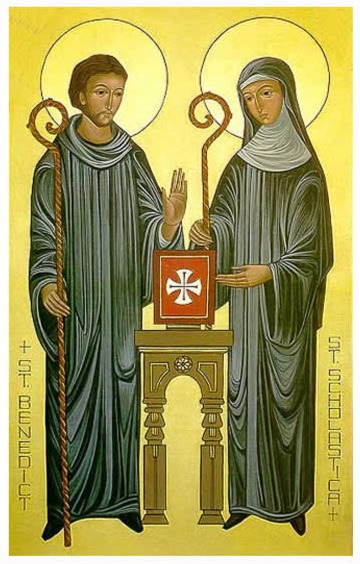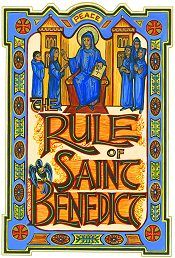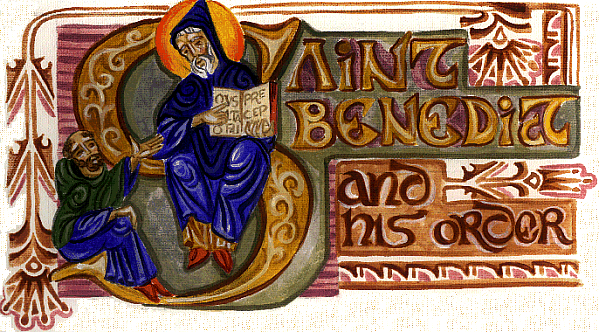St. Benedict: Man Of God, Man Of Miracles
- Dominus Est!
- Jul 4, 2020
- 5 min read
by Nerissa P. Gomez
FEAST DAY: July 11
St. Benedict, whose feast day we celebrate every July 11, is popularly known as the Father of Western Monasticism.
He introduced the monastic way of life of the Benedictine Order in the Middle Ages from the 6th century onward. This way of life is called Ora et Labora.
Our knowledge about St. Benedict was brought by the first five Missionary Benedictine Sisters who came to the Philippines on September 14, 1906.
Here are some important things we need to know about St. Benedict, as written by Pope Gregory the Great in Book Two of The Dialogues: Life of Saint Benedict.
1. He is from a royal family.
St. Benedict is believed to have been born around 480, the son of a Roman noble in the province of Nursia. He had a twin sister named Scholastica. Even from his younger years, he always had his mind focused on following and serving God. Though he was sent to Rome to continue his studies, he soon left this place because of its dissolute and lewd life. He preferred to be with God in solitude rather than be praised publicly by many. He chose to be alone with God in a cave for three long years with the help of a monk named Romanus. It was Romanus who brought him food and water for his daily nourishment.
2. He is a man of prayer and miracles.
As a man of God, St. Benedict dedicated his life for the holy purpose of serving God. He is known as a man of prayer. In his Holy Rule he said, “First of all, every time you begin a good work, you must pray to Him most earnestly to bring it to perfection.” (RB Prologue #4)
With great faith in God, St. Benedict was able to perform miracles by himself and through his followers, yun who received special orders from him. These miracles are all recorded in the Dialogues of Pope Gregory the Great:
His first miracle was when he made a broken sieve whole and sound. (Ch. 1)
He defied temptations e.g. a great temptation of the flesh. (Ch. 2)
He was able to stop the attempts on his life from those who did not want to follow his strict and rigid way of living. Examples are when he made the sign of the cross on a glass with poisoned wine and when he prayed over a poisoned loaf which was carried off by a crow. (Ch. 3, 8)
He too had the power to cast away the evil spirit in a monk who would not stay at his prayers. (Ch. 4, 33)
He brought forth a fountain from the top of a mountain. (Ch. 5)
Through another monk, an iron head of a bill from the bottom of the water was returned to its handle again. (Ch. 6)
He made a monk walk on water and saved another disciple from drowning. (C. 7)
He was able to move a huge stone by prayer. (Ch. 9)
He put out a huge fire which monks believed would burn down the kitchen. (Ch. 10)
He brought dead boys back to life. (Ch. 11, 32)
He cured a boy with leprosy. (Ch. 26)
He released a poor man from his debts. (Ch. 27)
He did not break a glass window after throwing out a bottle of oil.(Ch. 28)
He filled an empty barrel with oil. (Ch. 29)
He loosened the cords of a peasant who was bound by merely looking at the man’s arms. (Ch. 31)
Even after he departed from this earth, miracles continued to happen in his name. A mad woman was cured when she slept for a night in the cave where St. Benedict stayed for 3 years. (Ch. 38)
3. He was also famous for his gift of prophecy and vision.
He foretold what was to happen to his monks and related to them the things that were done in his absence. Then they all realized that nothing could be hidden from venerable Benedict.
He revealed that his monks had eaten out of the monastery while on a journey. (Ch. 12 & 13)
He exposed how King Totila tried to deceive him by asking one of his generals to pretend to be him and approach St. Benedict on his behalf. (Ch. 14)
He prophesied to King Totila and to the Bishop of Camisina of their defeat. (Ch. 15)
He predicted that a certain clergyman would be delivered from the devil for a while but will be possessed once more. (Ch. 16)
He foretold the suppression of one of his own abbeys. (Ch. 17)
He revealed his knowledge about a monk who hid a flagon of wine. (Ch. 18)
He publicized that one of his monks received certain handkerchiefs. (Ch. 19)
He unveiled the proud thought of one of his monks. (Ch. 20)
He advised his monks not to worry during a great famine. The next day, two hundred bushes of meal were found outside his room. The donor remained unknown. (Ch. 21)
He appeared in the dream of an abbot and a prior and instructed them on how to dispose of the building of the Abbey of Terracina. (Ch. 22)
He absolved certain nuns after their death. (Ch. 23)
He had cast out a boy, who left the monastery, after his burial from his grave. (Ch. 24)
He saw the soul of his sister ascend into heaven. (Ch. 34)
He saw the whole world represented before his eyes and the soul of Germanus, Bishop of Capua, ascending to heaven. (Ch. 35)
He prophesied to his monks his own time of death. (Ch. 36)
4. He wrote a book called the Holy Rule (The Rule of St Benedict)
St. Benedict wrote a book about living communally under the authority of an abbot for his monks. He called his Rule “a little rule for beginners.” If there is strictness, the purpose is to “amend faults and safeguard love.” (RB Preface, Prologue 46-47) This book serves as a guide for all the Benedictines around the world. This is read aloud in his communities at meals, to receive guests, or to educate novices. St. Benedict believes that hearing words once is not enough: "We wish this Rule to be read frequently to the community."
5. He established 12 monasteries.
He founded numerous monasteries where he gathered his disciples into one whole community directed under the Holy Rule. These monasteries became the roots of the Church's monastic system.
6. He is the patron saint of Europe and students.
St. Benedict is often pictured with a bell, a broken tray, a raven, or a crosier.
Although St Benedict died on March 21, 543, his feast day is celebrated on July 11.
**Mrs. Nerissa P. Gomez is a Christian living Education teacher of St. Scholastica's College Manila, a Benedictine School.
























Thank you so much Ms Gomez for this article. It's a perfect introduction to St Benedict, especially for those who have never encountered the wisdom of Ora et Labora and his other teachings.
Interested to know the writer's personal experience of having St. Benedict as her patron saint; her "soul story" & "Dominus Est/New Evangelization" testimony... How she authentically lives out, as a Christian Living Education teacher, St. Benedict's inspiring example --- esp. amidst today's challenges. How one or more of those she listed (including the miraculous St. Benedict's Medal she didn't mention) positively transform her life (: